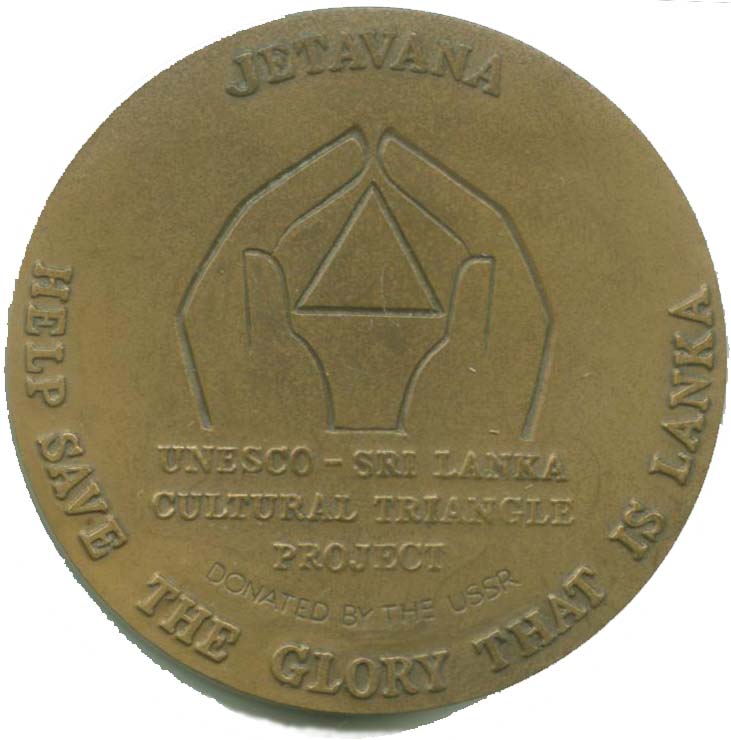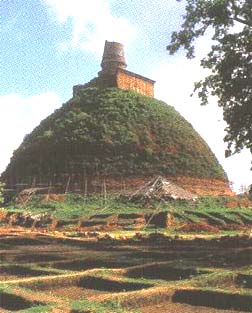| SPECIFICATIONS | |
| Alloy | Brass |
| Type | Struck |
| Diameter | 59.8 mm |
| Thickness | 7.4 mm |
| Weight | ~113 gms |
| Shape | Round |
| Edge | Plain |
| Die Axis | 0° |
| Mint | USSR |


|

| 
| ||||||||||||||||||||
 Built by King Mahasen (277-304 CE. it is the largest stupa in the
world. It occupies approximately eight acres of land.
Built by King Mahasen (277-304 CE. it is the largest stupa in the
world. It occupies approximately eight acres of land.
International Council on Monuments and Sites. in it's 1981 evaluation of Anuradhapura said
Anuradhapura, founded during the 4th century BCE The Chronicles of Mahanama, a narrative written a thousand years later, affirms that it was founded in 380 BCE by the prince Pandukabhaya), quickly became, on the island, both the capital of Lanka and the sacred city of Buddhism, Toward 250 B.C., the king Ashoka sent his son Mahinda to convert Tissa, the grandson of Pandukabhaya, and the latter became, thereafter, the first Buddhist sovereign (devananpiya) of Lanka. A second mission, led by Sanghamitta, Buddhist nun and daughter of Ashoka, brought Tissa a cutting from the Ashvattha, the sacred fig tree of Bcdhgaya, under which Siddharta attained spiritual enlightenment and supreme wisdom.
With the exception of the brief period of the invasion of the Tamil princes, at the beginning of the 2nd century B.C., Anuradhapura remained the political and religious capital of Lanka during ten centuries. Its apogee was reached under the reign of Dutthagamini who, in 161 B.C., expelled the Tamil invaders, re-established Buddhism in the place of Brahmanism and endowed the Site with extraordinary monuments: Dagaba Mirisaweti, Dagaba Ruvanwelisaya, the "Brazen Palace", etc.
Anuradhapura was sacked and taken by the Pandyan kings during the 9th century and then returned against payment of a ransom. The majority of the monuments were restored but the City never recovered from a final seige (993 B.C.), during wtuch the king Chola Rajaraja I destroyed it. Having lost its position as capital, it was deserted in favor of Polonnaruwa.
ICOMOS recommends the inscription of Anuradhapura on the World Heritage List on the basis of criterion II, III and VI.
Criterion II - The sacred City exerted a considerable influence on the development of architecture during several centuries. It includes remarkable monuments, particularly the Dagabas of colossal size, placed on circular foundations and surrounded by a ring of monolithic columns, characteristic of the Sinhala stupas.
Criterion III - Anuradhapura attests a unique and specific way to the Sinhala civilization, On numerous occasions the City was submitted to the assaults of invaders from southern India: the Tamils, Pandyas . Cholas. It stands as a permanent manifesto of the culture of Lanka - impervious to outside influences.
Criterion VI - The city is one of the principal shrines of Buddhism. The cutting from the fig tree of Buddha, brought there in the 3:d century B.C., has flourished and, today, the Bodhi-tree spreads out over the center of the site from a sanctuary near to the "Brazen Palace". The relics of Siddharta have, moreover, shaped the religious topography of Anuradhapura, where the Dagaba Thuparama was built by the king Tissa in the 3rd century BCE to house the clavicle of Buddha, an important religious relic presented by Ashoka.
For a beautiful interactive spherical panoramic views of Jetavanarama look at image which is one of 9 images for Ancient city of Anuradhapura Heritage site.
The medal which is one of a set of six were minted in 1987 and donated by USSR, to Central Cultural Fund (CCF) probably as a fund raiser.
The Medal was scanned at 300 dpi and displayed at 100 dpi. It was purchased in 2005 March from CCF office in Kandy.